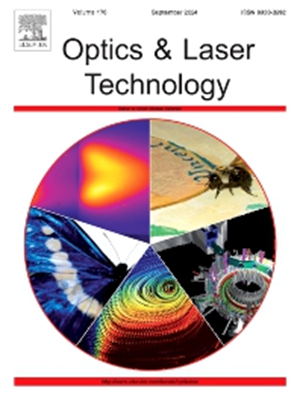Optimization and arbitrary frequency stabilization of probe laser based on a transfer cavity in SERF Co-Magnetometer
IF 4.6
2区 物理与天体物理
Q1 OPTICS
引用次数: 0
Abstract
We demonstrate an arbitrary frequency stabilization technology that can ensure both the frequency stability and tunability of the probe laser in a spin-exchange relaxation-free (SERF) atomic co-magnetometer at the frequencies far from the atomic resonance line. In theory, the non-negligible coupling between the cavity length locking and the locked laser frequency is identified and a transfer function model for the frequency stabilization system is established. The modulation multiplexing cavity length locking method and dual-phase modulation sideband locking method are designed to overcome the limitations of traditional transfer cavity method, including noise coupling and insufficient frequency tunability. Experimental results show that at a frequency far from the atomic resonance line, the Allan deviation after the frequency locking reached 8.223 × 10−11 for an averaging time of 103 s, which is lower by approximately two orders of magnitude than the frequency instability of free running laser. The research work is of great significance to improve the frequency stability, frequency tunability, cost-effectiveness, and compactness of the far-detuned probe laser in a SERF atomic co-magnetometer.
求助全文
约1分钟内获得全文
求助全文
来源期刊
CiteScore
8.50
自引率
10.00%
发文量
1060
审稿时长
3.4 months
期刊介绍:
Optics & Laser Technology aims to provide a vehicle for the publication of a broad range of high quality research and review papers in those fields of scientific and engineering research appertaining to the development and application of the technology of optics and lasers. Papers describing original work in these areas are submitted to rigorous refereeing prior to acceptance for publication.
The scope of Optics & Laser Technology encompasses, but is not restricted to, the following areas:
•development in all types of lasers
•developments in optoelectronic devices and photonics
•developments in new photonics and optical concepts
•developments in conventional optics, optical instruments and components
•techniques of optical metrology, including interferometry and optical fibre sensors
•LIDAR and other non-contact optical measurement techniques, including optical methods in heat and fluid flow
•applications of lasers to materials processing, optical NDT display (including holography) and optical communication
•research and development in the field of laser safety including studies of hazards resulting from the applications of lasers (laser safety, hazards of laser fume)
•developments in optical computing and optical information processing
•developments in new optical materials
•developments in new optical characterization methods and techniques
•developments in quantum optics
•developments in light assisted micro and nanofabrication methods and techniques
•developments in nanophotonics and biophotonics
•developments in imaging processing and systems

 求助内容:
求助内容: 应助结果提醒方式:
应助结果提醒方式:


